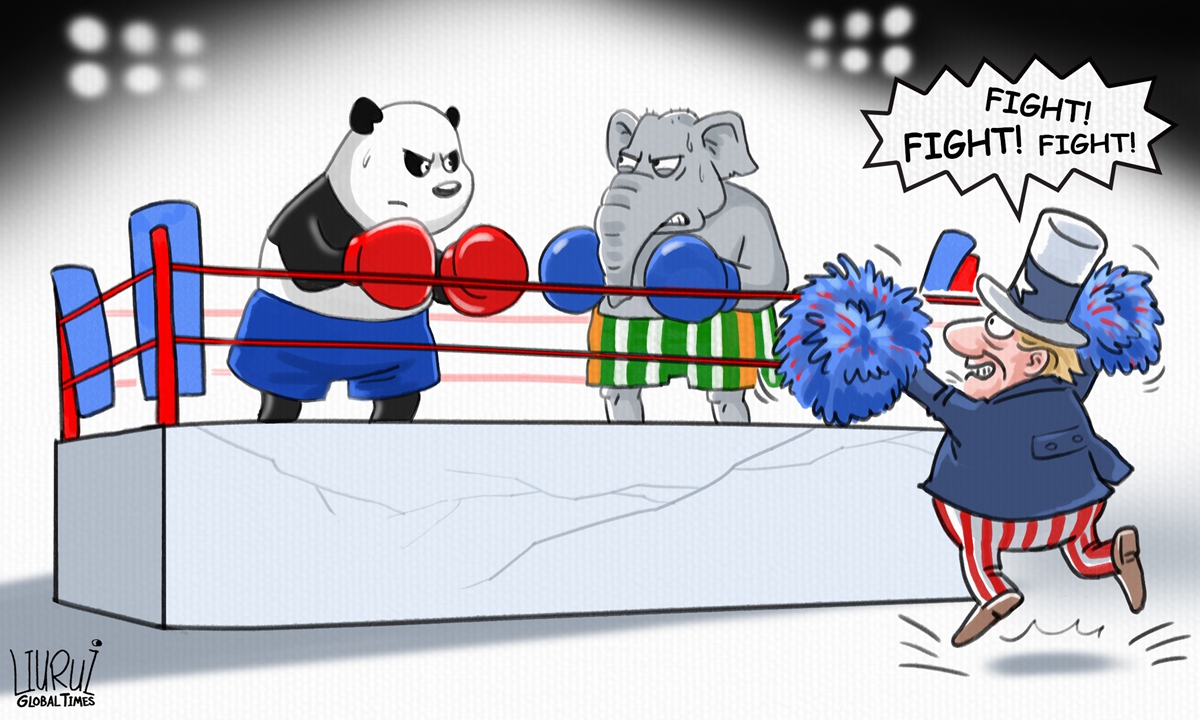Pressuring China with US-India naval drills is pure vanity
Source: Global Times Published: 2020/7/21 18:26:51

China India Photo: GT
A US carrier strike group led by the aircraft carrier USS Nimitz conducted military exercises with Indian warships near the Andaman and Nicobar archipelago on Monday.
As China-India border tensions linger and nationalist voices rise within India, demanding New Delhi to step up pressure on Beijing in the sea to "acquire leverage over China," this joint navy exercise has excited Indian media.
They widely interpret this as a "strong strategic signal to China" and "a show of solidarity" between the US and India amid tensions both countries face with China.
Beijing doesn't have to buy such rabble-rousing. It's normal for Washington and New Delhi to conduct joint military exercises. The US conducts drills with many countries around the world every year. This is not the first time for Washington and New Delhi to engage in naval exercises. As long as the third-party exercises don't harm China's interests, China doesn't have to feel targeted, or get annoyed.
Besides, defense cooperation has grown over the years to become a key component of the overall bilateral partnership between India and the US - especially since US President Donald Trump's visit to India in February 2020, his first such visit to the country.
During that trip, India and the US issued a joint statement agreeing to "deepen defense and security cooperation, especially through greater maritime and space domain awareness and information sharing; joint cooperation; exchange of military liaison personnel; advanced training and expanded exercises between all services and special forces."
But noticeably, the clash in Galwan Valley has provided the US with an opportunity to strengthen cooperation with India and take advantage of China-India border disputes.
India and the US now have jointly conducted military drills in the Indian Ocean. The possibility cannot be ruled out that India may drop its neutral position over the South China Sea issue and join the US in the so-called freedom of navigation operations in the South China Sea.
It has become clearer that the US is now intent to push China on all fronts. In order to target China, the US has taken actions, or tried to rope in countries that have disputes with China. In the short term, these may put a certain amount of pressure on China with international public opinion. But it will not impact current geostrategic situations. What China needs now is not to be easily agitated by it. To the contrary, China should manage its own affairs well and remain calm and rational in the face of provocations.
Before sailing together with Indian warships in the joint drill, the USS Nimitz carrier strike group, along with another one led by USS Ronald Reagan, had completed dual carrier operations in the South China Sea. The US and India are obviously flexing their military muscles.
As COVID-19 infections keep hitting new high in daily cases in the US, what Washington should do most is to concentrate all energy and resources on curbing the pandemic at home - instead of stir up troubles overseas to divert domestic attention.
The more energy and resources the US spends on nonexistent threats (the imaginary and exaggerated "China menace"), the less it has to fight the COVID-19, which is the biggest enemy of the US now. From the long-term strategic perspective, the US decline will further accelerate if it takes this road.
Since the China-India border row began to simmer, New Delhi has been soliciting external support. However, no matter how hard India's media hype up the naval drill with USS Nimitz, the China-India border situation won't be affected. The Galwan Valley clash has damaged the morale of the Indian troops. Chinese troops, by contrast, got a morale boost by defending their country.
China will never give up an inch of its territory. Nor will it flinch in the face of invasions or attacks on its interests. Some Indians, like foxes that want to use a tiger's might to their own advantage, as the saying goes, are seeking support from the US. Such efforts will be in vain.
Instead of being led by the nose by the US, India should strengthen communications with China at the strategic level. After all, the two Asian giants are immovable neighbors. Both confront development conundrums. If India blindly follows the US, it will ultimately harm its own interests.
The article was compiled by Global Times reporter Yu Jincui, based on an interview with Tian Shichen, a retired navy captain, vice president of the Grandview Institution and director of the Center for International Law of Military Operations. opinion@globaltimes.com.cn
RELATED ARTICLES:
Posted in: ASIAN REVIEW